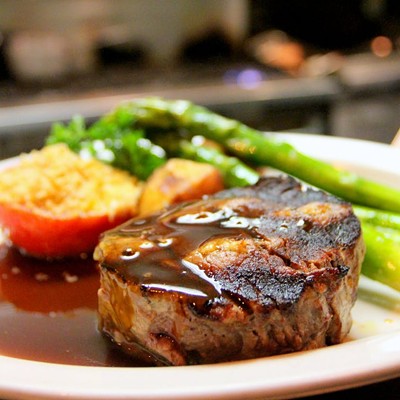"There's no need to rush anything," Frye calls out cheerfully. "Take your time."
But Frye does want her quintet of actresses and her solo actor to converge slowly on Crystal Fox, the young woman who plays a troubled Brooklyn teen saved by black church ladies in the American South. As the older women form a circle around her--a Greek chorus in flowered hats--their words take on a lilting chant: "She doesn't understand ... about the love that will make you change ... about arms that will hold you ... console you."
The Arizona Theatre Company production, Crowns, beginning previews this Saturday and opening Friday, Jan. 20, is an uplifting musical full of gospel songs, sung to the accompaniment of a percussionist and keyboardist performing live on stage. Based on an unusual book that paired photographs of real-life black church women in their glorious hats--their Crowns--with their oral histories, it's been given a unifying story for the stage by playwright Regina Taylor. The show played New York before turning into a regional hit.
The musical is full of movement, if not exactly the kind of Broadway-show dancing that's been the mainstay of Ellington's choreographic career.
"The emphasis is on the acting and singing," Ellington explains during a dinner break. "There's a lot of theatrical movement (like the older women circling the young woman) that's conducive to the plot. It tells the story. It's not intrusive. Andrea and I work together, and she looks to me to refine the movement in terms of dance and patterns."
The only bona fide dance number, the opening scene, is a "processional" that evokes the Middle Passage, she says, the Atlantic journey of Africans to their lives as slaves in America.
Ellington looks to the musical Urinetown as a model for what she's up to here. That breakthrough show, she notes, had actors who were not trained dancers successfully performing movement that was almost vernacular. "They accomplished a great deal," she says, and she's hoping for the same from the Crowns actors.
A lithe figure in black stylized sweats and jazz sneakers, Ellington is herself a rigorously trained dancer. A graduate of Juilliard, where she majored in ballet and minored in modern dance, she had a successful show dance career before turning to choreography. Tucson audiences have seen her work before, in Play On!, an ATC musical that went on to a Broadway run. And she's also choreographed for multiple first-run Broadway shows, from Sophisticated Ladies to The Night That Made America Famous, and in regional theaters throughout the country.
She was introduced to show biz at an early age, taken to the Apollo Theater in her native Harlem to see her famous grandfather perform.
"He was in New York very little," she says, "but it was like Christmas when he came. They would plant me in the audience, and it was my idea of heaven."
The live performances in those days would alternate with movies, and she'd sit for hours, watching Ellington live, then a movie, then Ellington again. Still, she wasn't tempted to become a musician.
"I knew he was something other than the ordinary," she says of Duke, "but I was not influenced by his music. I liked classical and rock 'n' roll, and I wanted to be a ballerina."
Ellington first took dance lessons at the age of 3, "a half-hour of this, a half-hour of that," and in her Catholic parochial school in Harlem learned Irish dancing for the annual St. Patrick's Day show.
"We worked all year for that show," she remembers. "We learned rhythm akin to tap."
A certain ballet doyenne by the name of Madame Povich taught the school's kids ballet, but when Ellington's grandmother, Louise Silas, inquired about after-school lessons, Madame always made excuses not to admit Mercedes.
"It became apparent that she didn't want black kids in her school," Ellington remembers.
Silas, who raised Ellington, was a "strong woman" who didn't hesitate to protest, not only with Povich but with the nuns for allowing a bigot in their school. Silas also found another dance school, where the teachers had been taught by a partner of the Russian ballerina Anna Pavlova. The training there was good enough to get Mercedes first a scholarship to the ballet school then run by the Metropolitan Opera, and then into Juilliard.
"I had a fabulous roster of teachers at Juilliard," Ellington remembers, from Martha Graham herself to Antony Tudor to Doris Humphreys. But on graduation, she found that America's ballet companies preferred to remain largely lily-white, a phenomenon that persists. Ellington turned to show dance, for her first job signing on for six months in Australia in a production of West Side Story. She also taught dance occasionally, in the New York public schools.
"At Juilliard, people talked about 'selling yourself out,' but it was the only way I could make a living as a dancer."
She broke some racial barriers, becoming the first black dancer on the old Jackie Gleason variety show. One time, Gleason himself protected her from racial slurs. The whole company was traveling by private train to Florida, when they stopped in a Southern town for a photo shoot. Harlem-bred, Ellington was nervous about the South, and "I was not going to get off that train."
Her colleagues insisted, but no sooner did she pose among the group when an onlooker angrily called out, "What's that colored girl doing there?"
Ellington tried to flee back to the safety of the train, but Gleason wouldn't have it. "He said, 'You're not going anywhere,' and then he grabbed me and tucked me under his arm," and defiantly faced the crowd.
Broadway was even tougher, she remembers, with black dancers often excluded from the big shows. She did get hired for No, No Nanette, and the show's choreographer, Donald Sadler, became a mentor. She assisted him with choreography, and after that, he hired her as assistant choreographer for other shows as well.
"I attribute my method of working to him," she says. "He's influenced by painting as well as music. And he taught me to be historically true, to research the period. Don't make fun of people, and don't make caricatures of them."
Ellington, who is now serving on the Tony nominating committee, says Broadway literally remains the "Great White Way," with black performers too often relegated to "black" shows like The Lion King and Aida.
"The fabric of America is ignored on Broadway," she says, even though recent successes like The Color Purple demonstrate that black audiences do exist.
Regional theaters, like ATC, are more willing to take risks, Ellington says, partly because the economics are so different. The smaller theaters don't have New York overhead, and they have built-in audiences in their subscribers. Crowns, she notes, "had a short life on Broadway, but now it's successful. It's had a whole other life in regional theater."
The play's story, about strong, wise black women, resonates in her own life. And so do the hats. Back in Harlem, Ellington would go to early Sunday Mass with her Catholic grandmother, but a Baptist Church on Convent Avenue had a later service. Young Mercedes would position herself in a good vantage point, and "watch the parade of women in hats."














